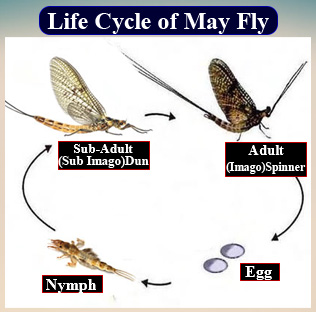
The lifespan of a mayfly is
(a) 1 day
(b) 2 days
(c) 3 days
(d) 4 days
Answer
567.9k+ views
Hint: Mayflies are small aquatic insects. Adult mayflies lack functional mouthparts thus unable to eat so they can not survive for longer durations. They have the shortest lifespan of all the animals.
Complete step by step answer:
The lifespan of a mayfly is 1 day.
The life cycle of mayflies passes through four stages: egg, nymph, subimago, and imago. Their sole purpose of existence is to pass on their genetics to a new generation in a very short period.

Eggs: Eggs are of a variety of sizes and shapes (oblong, oval, or rounded) having distinct surface detail. The female fly can produce fewer than 50 to more than 10,000 eggs based on the species. The eggs are laid in water. They usually hatch in about two weeks but depending on the circumstances may undergo a stage of varying duration where no growth occurs. This condition is called diapause (cessation of growth) that enables the insects to avoid stressful conditions.
Nymph: This stage is of variable length two weeks or two years.
Subimago: The nymph skin sheds and a winged form, called the subimago, or dun, arises. The subimago escapes the surface of the water to land. After a variable interval (a few minutes to several days usually overnight) , the skin is shed for the final time, resulting in the imago, or adult stage (a spinner). Its legs and tails are also shorter than those of the imago.
Imago: It resembles the subimago apart; it is softer and duller in color than the adult. Heavy pigmentation on the veins of the wings persists in the imago. Subimago and imago are usually considered as different species altogether.
So, the correct answer is ‘(a) 1 day’.
Note: Mayflies are named so because they are active during the warmer months of the year and May being one of the warmer months. Mayflies are the only insects that undergo molting after developing functional wings.
Complete step by step answer:
The lifespan of a mayfly is 1 day.
The life cycle of mayflies passes through four stages: egg, nymph, subimago, and imago. Their sole purpose of existence is to pass on their genetics to a new generation in a very short period.

Eggs: Eggs are of a variety of sizes and shapes (oblong, oval, or rounded) having distinct surface detail. The female fly can produce fewer than 50 to more than 10,000 eggs based on the species. The eggs are laid in water. They usually hatch in about two weeks but depending on the circumstances may undergo a stage of varying duration where no growth occurs. This condition is called diapause (cessation of growth) that enables the insects to avoid stressful conditions.
Nymph: This stage is of variable length two weeks or two years.
Subimago: The nymph skin sheds and a winged form, called the subimago, or dun, arises. The subimago escapes the surface of the water to land. After a variable interval (a few minutes to several days usually overnight) , the skin is shed for the final time, resulting in the imago, or adult stage (a spinner). Its legs and tails are also shorter than those of the imago.
Imago: It resembles the subimago apart; it is softer and duller in color than the adult. Heavy pigmentation on the veins of the wings persists in the imago. Subimago and imago are usually considered as different species altogether.
So, the correct answer is ‘(a) 1 day’.
Note: Mayflies are named so because they are active during the warmer months of the year and May being one of the warmer months. Mayflies are the only insects that undergo molting after developing functional wings.
Recently Updated Pages
Master Class 12 Business Studies: Engaging Questions & Answers for Success

Master Class 12 Economics: Engaging Questions & Answers for Success

Master Class 12 English: Engaging Questions & Answers for Success

Master Class 12 Maths: Engaging Questions & Answers for Success

Master Class 12 Social Science: Engaging Questions & Answers for Success

Master Class 12 Chemistry: Engaging Questions & Answers for Success

Trending doubts
What is meant by exothermic and endothermic reactions class 11 chemistry CBSE

Which animal has three hearts class 11 biology CBSE

10 examples of friction in our daily life

One Metric ton is equal to kg A 10000 B 1000 C 100 class 11 physics CBSE

1 Quintal is equal to a 110 kg b 10 kg c 100kg d 1000 class 11 physics CBSE

Difference Between Prokaryotic Cells and Eukaryotic Cells




